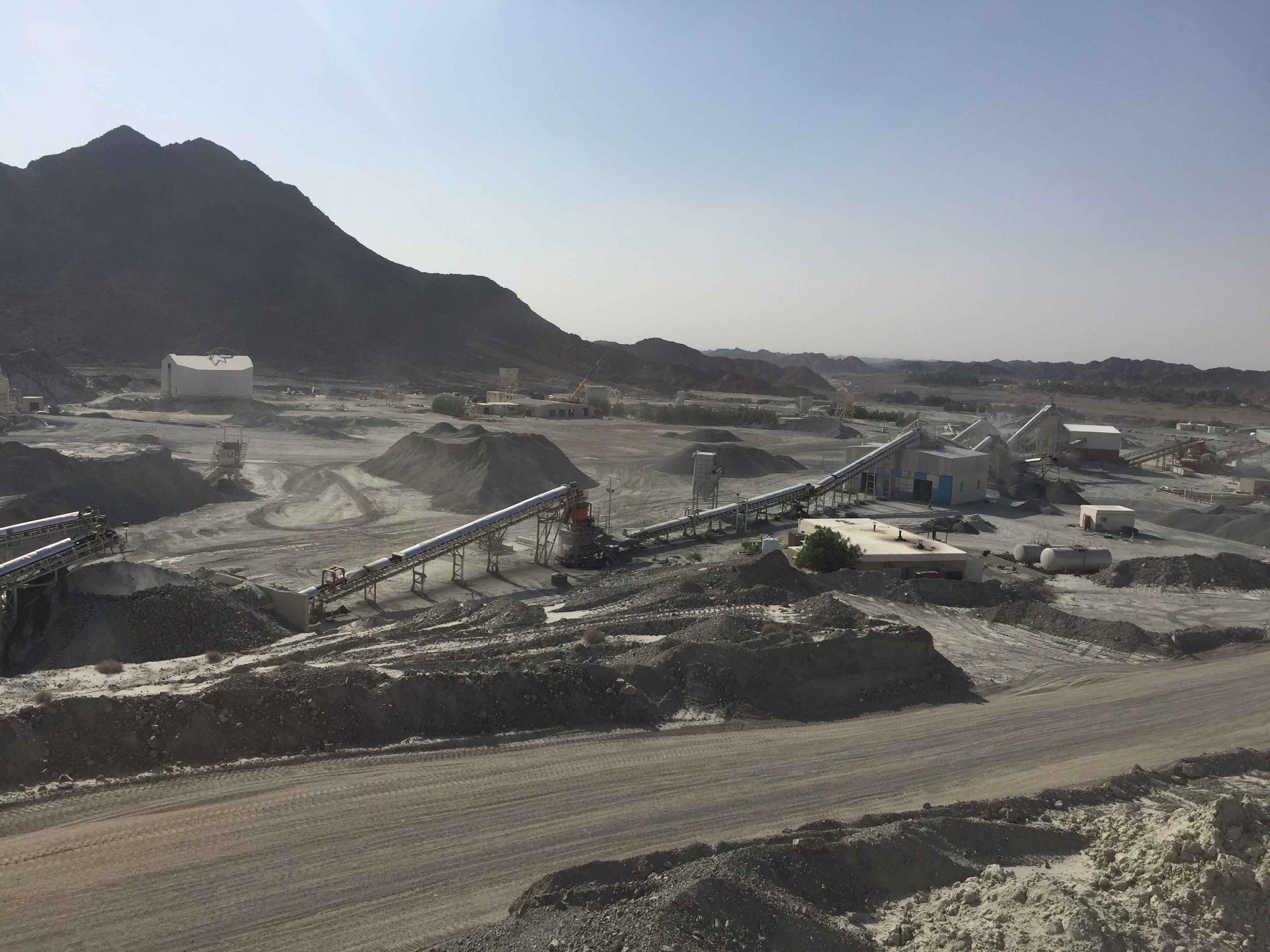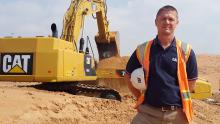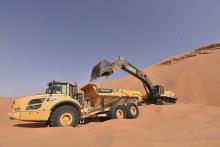
Aggregates demand in the Middle East is good but not exceptional – with huge spending on some major commercial and sporting infrastructure, partly negated by world oil price crisis-led postponements or cancellations of mega projects. Guy Woodford reports
There’s serious money in the Middle East, but not all of it, due to a number of different factors including plummeting oil prices, is being released for aggregate-hungry flagship building projects.
A recent report by Timetric, a major global industry research company, states that 14 of the major economies in the Middle East and Africa are currently investing or have earmarked investment of more than US$1 trillion in commercial and institutional projects. Leading the multibillion dollar investment league is the United Arab Emirates with investment of $687 billion, followed by Saudi Arabia’s $436 billion and Kuwait’s – still impressive - $158 billion pot.
Unsurprisingly, given such large investment sums, the Middle East and Africa (MEA) region will, says Timetric, also post the fastest regional construction industry growth in 2016, at 5.9%. This is despite that figure being a slight deceleration compared with the MEA region’s rapid growth of 6% and above in recent years.
The International Monetary Fund’s (IMF) January 2016 forecast identifies the Middle East, along with sub-Saharan Africa, as the key regional players behind a slight increase in global economic growth, from 3.1% in 2015 to 3.4% in 2016. However, the IMF also notes how global geopolitical and macroeconomic risks have increased considerably in 2016 compared with the previous year. Among geopolitical risks, the conflicts in the Middle East and in eastern Ukraine are considered to be especially noteworthy.
Despite these geopolitical concerns, with its admirable forecasted world-leading construction sector growth and massive commercial and institutional project funding, the Middle East is already a highly attractive market for both aggregate suppliers and construction equipment manufacturers. And both will have noted it can be even better still with the potential new business offered in Iran – the Middle East’s second-largest economy - after international sanctions against the country were lifted in January this year following its agreement to limit its nuclear development programme.
The lifting of nuclear weapon capability-related economic sanctions on Iran unlocks project investments worth up to $200 billion, claims MEED, the leading source of Middle East business intelligence. And Iranian President Hassan Rouhani has wasted little time in pursuing new business opportunities – overseeing $40 billion-worth of agreements with Italian and French companies during a five-day visit to Europe just days after the official lifting of sanctions. As MEED notes, more deals will follow as Tehran looks to kick-start its economy with investment in sectors from oil to transport to tourism.
Just like the rest of the world, the 2008 global financial crisis hit the Middle East hard. In Dubai, in the United Arab Emirates, the megaprojects for which it was famed ground to a halt and the quarries that supplied them, mostly in the northern emirates of Ras al-Khaimah and Fujairah, also fell silent. Now, as the likes of Timetric and MEED have noted, construction activity and confidence in Dubai, the other six UAE Emirates and the rest of the Middle East is returning. In the UAE’s case, the construction market recovery has been helped by preparations for the World Cup in neighbouring Qatar in 2022 and Dubai’s hosting of EXPO 2020.
Among the UAE quarries enjoying a revival is Unimix quarry in Fujairah. Opened in 2002, it boasts good quality rock (supplying aggregates used in the Burj Khalifa super skyscraper and rock armour for Dubai’s Palm Islands), but has been operating at a low level since 2008. That all ended when Global Crushing Solutions (GCS) signed an agreement to take over full control of the quarry in 2014. Led by Brian Kearney and Trevor Mortimer, friends who met at mining school in their native Ireland, along with compatriots Brian McGinnity and Paddy Grace, they bring a wealth of mining and quarrying experience, learned in Europe, Australia – and even gold mining in Mauritania.
Bolstered by major contracts with leading cement and ready-mixed concrete companies, the core team – supported by an existing workforce of 82 people – have set to work on the site. But before they could start extracting the 200 million tonnes of limestone and 20 million tonnes of red shale in the current licence, the site operations needed a complete overhaul.
“We are using 3D modelling of the pit,” says Brian Kearney. “This is common in mining and allows us to control what comes down the mountain by planning the loads for months to come.”
The high expectations of the team were never going to be delivered by the equipment on the site. So before operations began in earnest, the ancient 70-year-old Russian-sourced crusher, originally built to process uranium, was completely overhauled. And having worked 50-60,000 hours, the mobile equipment was in no better shape. “We inherited more of a machine graveyard than a fleet of serviceable machines,” jokes Kearney. “Using simulation software, our analysis told us we needed 16 pieces of good quality mobile equipment in order to do the job properly.”
Then came a series of negotiations with the leading brands, with
The fleet now includes two 70tonne Volvo EC700C excavators that handle primary loading at the face. A 48tonne EC480C excavator works in support, fitted with a breaker to reduce toolarge rocks, as well as general site development duties. A team of seven 35tonne A35F articulated haulers then haul the 1.4km to the crusher, achieving the round trip in a little over nine minutes.
Waiting for them are five L220G wheeled loaders, who load the finished product of 5mm, 10mm and 20mm aggregate onto the 260 trucks that will enter the site each day when up to full production.
The team is also bringing world-class environmental practices to the site – a great relief to the 800 residents of a nearby village. These include sound barriers and water suppression systems. “The locals are pleasantly surprised,” says Kearney. “There are now much lower noise and dust levels – 70-80% lower than before. We have also added covers to the conveyors, top sheets and de-dusters in the main plant.”
Safety is also a high priority – another innovation for the site – and includes thorough machine training from Volvo’s UAE dealer FAMCO, speed restrictions, widening of haul roads and a reduction in their steepness, from 1:7 (one metre incline every seven metres) to a maximum of 1:10 today. All machines are fitted with flashing beacons and fire extinguishers, while the haulers (and soon the loaders) are also fitted with reversing cameras.
As the world’s biggest building materials manufacturer, many look to
Aggregate producers across the Middle East are looking to supply firms involved in the myriad of current projects centred on the road infrastructure and transport sectors in Saudi Arabia, the region’s biggest single nation. Bringing together government officials, project owners, contractors, consultants, equipment suppliers and technology providers, The Bridges & Highways Bahrain & Saudi Arabia Conference 2016 (18-20 April) was due to hear how US$16.8 billion (SR63 billion) was allocated to the sectors in 2015 alone. In Saudi Arabia, an estimated $8.9 billion (SR33.5 billion) is going on funding almost 2,000km of new roads, railways, railways and infrastructure projects. Bahrain is also spending over $2.5 billion in the next decade on infrastructure projects including new road networks and construction. In addition, there is also a proposal to build a causeway between Saudi Arabia and Bahrain that meets new specifications.
Meanwhile in Oman, a factory of 25,000m² in Samayil has been unveiled by Oman-based stone supply and installation contractor Natural Stone. The state-of-the-art plant of Al Ansari Trading’s arm is the biggest of its kind in the country.
Luis Santos, the company’s senior vice president AMET (Africa, Middle East and Turkey), sees three distinct market areas in the region. “There is the United Arab Emirates and the Gulf countries, where aggregate demand is quite high but not booming. Then there’s Saudi Arabia and, finally, Iran, which is still a question mark for all of us.
“The UAE demand is quite high due to the requirements of the Expo 2020 in Dubai, and the 2022 World Cup in Qatar. It’s not booming as all the barges carrying aggregates cannot be emptied at port due to a dispute. Since last August or September, there’s been something like 400 barges in the sea, between Doha in Qatar and Fujairah [UAE] ports. The situation was meant to be resolved but has not been. There are a couple of million tonnes of aggregates still at sea.
“Saudi Arabia’s market is good but it was booming up until March last year. Since the world oil price crisis started, pushing the oil price down to almost US$30 a barrel, the country’s government has cancelled some of its planned so-called mega building and infrastructure projects. Those where works contracts have been awarded have been postponed or cancelled, like the high-speed train from Jeddah to Riyadh. The Saudis need to balance their deficit right now.
“Iranian aggregate demand is at least 250 million tonnes a year. The internal annual consumption of cement alone is between 38 and 39 million tonnes – that’s almost double that of Nigeria, a country that everyone was saying was booming as an aggregates market. This shows how important Iran could be for all of us.”
Santos says there’s huge demand in the Middle East, particularly in the “extremely competitive” UAE market, for expert OEM service advice on how best to adjust quarrying and construction fleet model capacities in order to secure the lowest possible operating costs. “It’s where we can make the most difference,” he stresses.
“The underlying demand for aggregate in the GCC region is high but the market is currently heavily impacted by the low oil price and the security situation in the region,” says a company spokesperson. “Most of the countries in the GCC region are exposed to the oil price fluctuation. The current low oil price is causing sizeable negative impact on government spending in oil-producing countries like Saudi Arabia and Oman, but the oil price fluctuation impacts more or less all countries in the region.
“Many GCC countries are also involved in the ongoing conflicts in the region. The fragile security situation in Iraq, Libya, Syria, and the Republic of Yemen is causing sizeable negative impact on government spending in many countries which has a negative impact on the overall aggregate demand.”
The current Middle East market situation is, says the Sandvik spokesperson, causing negative impact on the overall construction equipment demand. “There are also concerns among contractors if they will get paid for their projects or not (even for Government funded projects), which also negatively impacts demand.”
The Sandvik spokesperson says financing support for buying or renting the company’s wide range of stationary and mobile crushing and screening equipment is now more important due to the poor liquidity situation in the region’s markets.
Of how aggregate demand may change in the next five years, the spokesperson says: “The outlook will depend on the oil price development and security situation in the region. The baseline scenario assumes that the security situation in the region will remain fragile during the coming years.
“When the situation stabilises the demand for aggregate will rise as postponed projects will start up again and new infrastructure projects will be initiated. Iran will also play an important role in the coming years as the sanctions now are lifted.”









